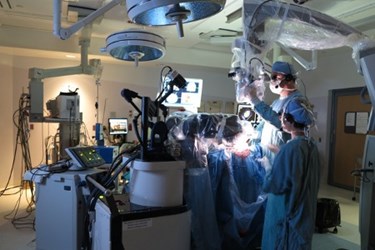From The Space Station To The Operating Room
By Sara Jerome,
@sarmje

Robotic arms based on International Space Station (ISS) technology may be a highly-effective tool for brain surgery, according to a new study.
“A machine is inherently more precise and accurate than a human, as it can move in increments of microns while humans move in increments of millimeters,” said Garnette Sutherland, neurosurgery professor at the University of Calgary in Canada, who worked on the study.
The research, published by the Journal of Neurosurgery, focused on an image-guided surgical tool known as neuroArm, manufactured by IMRIS Inc. The machine was designed “to work in conjunction with an MRI machine, as well as actually inside an MRI. This gives surgeons the ability to continually monitor their progress through detailed, three-dimensional images.” Surgeons operate the system remotely, via a “sensory immersive” workstation.
“Surgical robots have the potential to improve surgical precision and accuracy through motion scaling and tremor filters, although human surgeons currently possess superior speed and dexterity,” the journal article said.
The study predicted that robotic technology is going to play an increasingly pivotal role in surgery: “NeuroArm is a step toward a future in which a variety of machines are merged with medicine.”
The technology behind the NeuroArm was originally developed by the Canadian Space Agency and was used on board the space shuttle and the ISS, according to a write-up from NASA.
Robotic surgical devices have come under criticism recently.
“There have been widely publicized horror stories, including patients who have bled out after a robotic instrument inadvertently nicked a blood vessel or those who have been injured in other ways, such as accidental punctures, tears or burns,” the Wall Street Journal recently reported.
The American College of Obstetricians and Gynecologists falls among the skeptics.
The group believes that “robotic surgery is not the only or the best minimally invasive approach to hysterectomy … nor is it the most cost-effective,” according to the WSJ.
Intuitive Surgical’s da Vinci robotic surgical system received mixed reviews from the FDA in a recent report.
But patient outcomes were largely smooth in the University of Calgary study.
“Only 1 adverse event was encountered in the first 35 neuroArm cases, with no patient injury. The adverse event was uncontrolled motion of the left neuroArm manipulator, which was corrected through a rigorous safety review procedure,’ the study said.
This isn’t the only piece of ISS tech attempting to make the leap from space to the operating room. A research team at Canada’s Centre for Surgical Invention and Innovation (CSii) are initiating clinical trials of the Image-Guided Autonomous Robot (IGAR) for early diagnosis and treatment of breast cancer.
Image credit: Project neuroArm, University of Calgary
